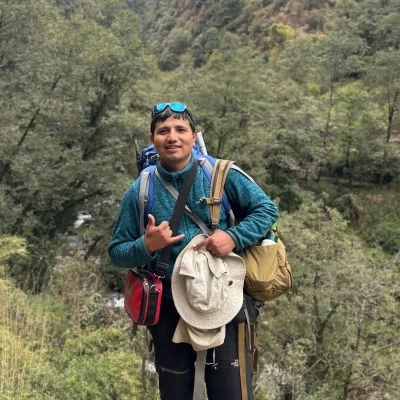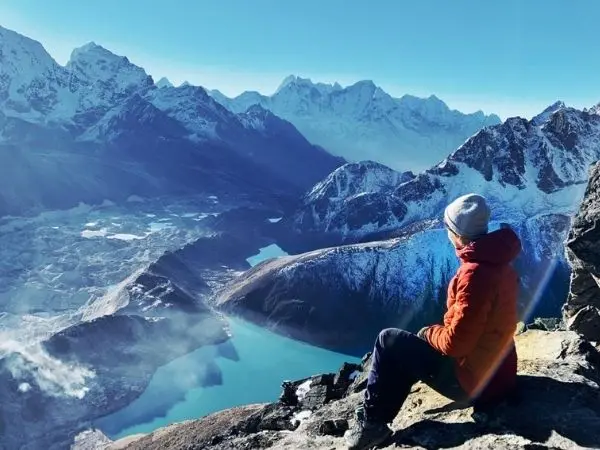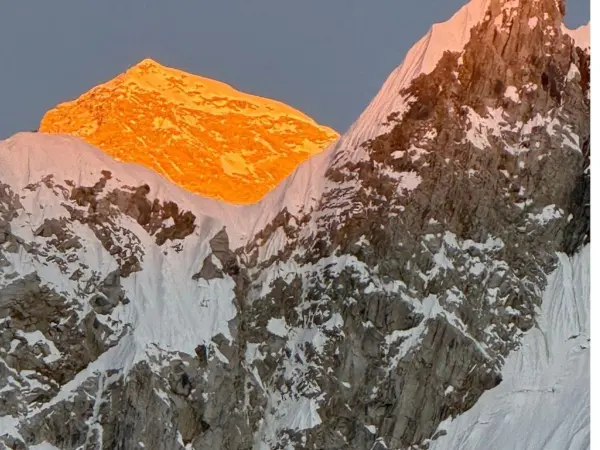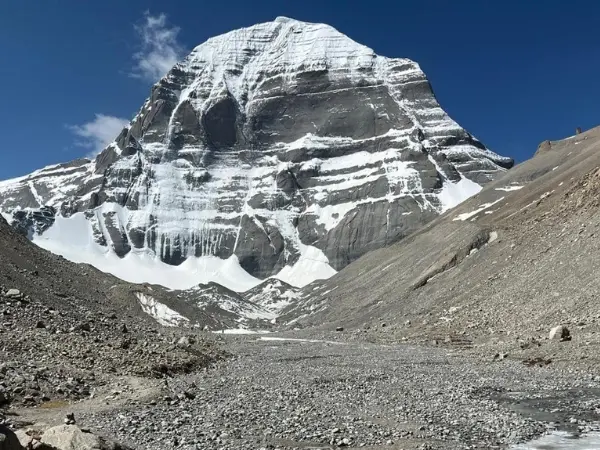The reason for altitude sickness is due to low oxygen at high elevations and starts with a symptoms like headache, nausea, dizziness, fatigue and poor sleep. To cure from this, prevention includes slow ascent, proper acclimatization, staying hydrated, eating well, avoiding smoke and alcohol. Mild AMS can be improved with rest, hydration and medicines like Diamox, while serious symptoms require immediate descent, oxygen therapy and sometimes an emergency evacuation.
Comprehensive Guide to Altitude Sickness
What is Altitude Sickness?
Altitude Sickness also known as Acute Mountain Sickness (AMS), is the reaction from our body when it struggles to adjust to the oxygen levels found at high altitude. As you climb high, faster than your body can adapt, it struggles to provide enough oxygen to your brain, muscles and other vital organs which leads to the common altitude sickness problem.
Symptoms of Altitude Sickness
Mild AMS Symptoms
Mild Aws Symptoms are for earliest warning that your body is struggling to adapt to high altitude. These symptoms often appear within the first few hours (6-12 hours) of you reaching to a new height. These symptoms should not be ignored as treating them early helps us to prevent from dangerous altitude illness.
Persistent Headache :A persistent headache is one of first altitude sickness symptoms and a sign your body isn’t adapting at high altitude and low-level oxygen levels. This reduced oxygen levels can cause slight swelling in the brain which also leads to dull or throbbing pain. While mild painkillers can provide a relief but any headache during Acute Mountain Sickness (AMS) must be treated seriously.
Nausea and Occasional Vomiting :Nausea is a common altitude sickness symptom at high altitude. As Acute Mountain Sickness (AMS) develops, it can lead to vomiting especially when a person attempts rapid ascent without proper acclimatization. These symptoms can usually be treated with proper rest, hydration and pausing your climb to prevent from more serious illness like HAPE or HACE.
Fatigue and Unusual Tiredness :Fatigue is one of the most common altitude sickness symptoms at higher altitude. Even simple activities start to feel tiring because your brain and muscles are not getting enough oxygen. If this unusual tiredness increases with time, it’s better to stop climbing and have an enough rest so that your body adapt with the environment before Acute Mountain Sickness (AMS) becomes more serious.
Dizziness or light headedness:Dizziness or feeling lightheaded is another altitude sickness symptom which is caused by brain receiving less oxygen during high-altitude travel. This symptom leaves you momentarily unstable and mentally foggy. Resting, hydrating and slowing down usually help but if persistent dizziness occurs it is indicating worst Acute Mountain Sickness and treatment should be done immediately.
Loss of appetite : Loss of appetite is an ordinary altitude sickness symptom at higher elevations. It can affect digestion, making food less appealing even when our body needs more calories for proper acclimatization. Eating small, frequent and carb rich meals can help us to maintain energy and prevent altitude sickness from getting worse.
Insomnia (Difficult in Sleeping):Insomnia at high altitude occurs because of breathing patterns as it gets irregular during sleep. Many people suddenly wake up because they feel breathless, restless and unable to stay asleep. While Insomnia isn’t that dangerous but poor sleep isn’t good which can slow down acclimatization and increases the chance of developing Acute Mountain Sickness (AMS).
Shortness of breath during exertion:You may feel harder suddenly than usual while climbing stairs or uphill even though you are fit individuals. This is due to lungs worked for overtime to absorb oxygen from thinner air making occasional breathlessness. Occasional breathlessness might be normal symptom, but regular shortness of breath is serious Acute Mountain Sickness which needs an immediate attention.
Swelling of Hands, Face, or Feet (Mild Edema):At higher altitude your body may retain extra altitude meaning your body keeps more water than usual. These extra fluids can accumulate in your hands, feet or face causing them look swollen or puffy. Swelling is harmless most of the time as it is indicating that our body is adjusting slowly and it usually improves with proper hydration and rest.
Moderate AMS Symptoms
Moderate altitude sickness means that altitude sickness is worsening and must be treated immediately. At this stage your body is failing to adapt with environment and ascending upward can be really dangerous. Immediate rest, monitoring and descent (if necessary) are very important to prevent from serious complications like HAPE or HACE.
The Moderate Acute Mountain Sickness symptoms include:
Severe Headache (Not Relieved by Medication):When earlier painkillers didn’t work, now it is a serious altitude sickness symptom. This type of headache usually worsens when person starts to move and feels more difficult than typical AMS discomfort. This shouldn’t be ignored and must be treated immediately.
Increase Nausea and Repeated Vomiting:Regular vomiting is signaling that your digestive system is not working under these high-altitude regions. This causes dehydration and makes every symptom even worse. If vomiting doesn’t stop, descending is the safest option.
Reduced Coordination (Ataxia):Trouble with balance (Clumsiness) while walking means that your brain is not functioning properly due to the lack of oxygen. This symptom (Ataxia) is a red flag that Acute Mountain Sickness (AMS) is progressing into a dangerous stage. Anyone with this sign from the body should stop moving and descent immediately.
Marked Fatigue and Weakness :Extreme fatigue and weakness at high altitude are serious concerns. Even simple movement starts to feel so exhausting and tiring which means that body is under severe altitude stress. This symptom is clearly instructing that you need to slow down, rest and allow proper acclimatization.
Shortness of Breath Even at Rest : Even while resting you feel difficult to breathe, which is major warning sign that oxygen levels in your blood are dropping significantly. This is more serious than normal exertional breathlessness. Immediate descent and medical attention are required to prevent from other high-altitude emergencies.
Severe AMS (Life Threatening Conditions)
When Acute Mountain Sickness (AMS) advances it reaches to severe AMS stage, where brain or lungs can be filled with fluid, making the symptoms life threatening within hours. This can worsen rapidly at high altitude, so immediate descent and urgent medical attention are extremely crucial to save lives.
HACE - High Altitude Cerebral Edema (Brain Swelling) :
HACE occurs when fluid leaks into brain tissue due to severe oxygen loss. It spreads quickly and can even lead to coma if it is not treated urgently. All HACE symptoms listed below are an emergency situation, so an immediate descent and medical treatment are extremely important.
Confusion or Disorientation:Confusion or disorientation at high elevation is a serious altitude sickness symptom and a clear warning of HACE. As brain is not getting enough oxygen, it has difficulty for thinking and responding normally.
Inability to Walk Straight (Ataxia) : When person is unable to walk in a straight line or if he is suffering frequent stumbling, it is a serious symptom of HACE as brain is not coordinating with body properly. In such cases, descent is compulsory with immediate medical attention.
Hallucinations:If person is seeing or hearing things that are not real then it is called Hallucinations. It is a serious HACE symptom and a critical sign from our body of dangerous attitude sickness. This happens when brain is extremely low on oxygen. Immediate descent, oxygen therapy and urgent medical care are very important in such condition.
Loss of consciousness : Loss of consciousness is a final warning or signal from our body that it is in most dangerous stage of altitude sickness. The brain is receiving almost no oxygen and causing the person to faint or loss consciousness completely. At this situation evacuation is the only option as without proper treatment, survival of person becomes less possible.
HAPE – High Altitude Pulmonary Edema (Fluid in the Lungs)
HAPE occurs when the fluid builds up in the lungs at high altitude which makes lungs to absorb oxygen extremely hard. It starts with mild symptoms but gets worsen rapidly at night or during physical activity. Proper medical treatment and urgent descent are vital to prevent from this life-threatening stage of altitude sickness.
Shortness of Breath Even When Resting:If person is struggling to breathe while even sitting or lying down it is a major HAPE symptom. In this stage lungs are filled with fluid which makes oxygen exchange almost impossible. This situation requires immediate descent and oxygen support to prevent from a life-threatening emergency.
Persistent Cough (Frothy or Pink Sputum):A wet cough with foamy or pink mucus means that fluid is leaking into the lungs at high altitude making it a serious HAPE symptom. This is one of the most dangerous signs of altitude sickness, so fast descent and urgent medical treatment are essential to save a life.
Chest Tightness : A feeling of heaviness or pressure in chest areas means that lungs are under serious problem. Many people describe it as “drowning from inside” and it worsens quickly and can cause a respiratory failure. In such situation urgent evacuation is mandatory to prevent from life threatening emergency.
Blue Lips or Fingernails (Cyanosis):Blue lips or fingernails is a condition called cyanosis, bluish skin occurs when oxygen levels are dangerously low in the blood. It is a critical and visual sign that body is struggling internally. Anyone with cyanosis symptom needs an immediate descent with emergency medical care.
Rapid Heart Rate: A Rapid Heart Rate means that body is not getting enough oxygen and heart is beating faster to compensate the low oxygen in your body, but heart can’t keep this up for long. Emergency action or evacuation is crucial in such cases.
Causes and Risk Factors
Primary Cause
The primary cause for altitude sickness is low oxygen pressure at high altitude regions which makes the amount of oxygen very low entering into our bloodstream. As air gets thinner, the body needs to work harder to supply enough oxygen to vital organs and tissues.
Risk Factors Include
Each of the below risk factor increases the chance of progressing AMS (Acute Mountain Sickness) and should be taken seriously.
Rapid Ascent without Acclimatization :Climbing too fast doesn’t give body the enough time to adjust with decreasing oxygen levels environment. This sudden change disturbs the body’s natural acclimatization process. So slower ascents are vital to reduce this risk.
Sleeping Altitude Rising Too Fast :Ascending to a higher sleeping altitude too quickly puts an extra pressure to the body at night. Due to this, the body recovers less effectively at high altitude, making symptoms to appear. So, it’s important to follow high altitude strategy “Climb high, sleep low” to improve acclimatization process.
Past History of Acute Mountain Sickness (AMS) :If you had altitude sickness before, there is more chance that you will get it again as your body maybe naturally slower at acclimatization. So extra caution and preventive measures are very important for such persons.
Physical Overexertion Early in the Trek :Beginning a trek with too much physical effort for first days increases oxygen demand to your body before it has adjusted to high altitude. This usually leads to symptoms like headaches, nausea and fatigue. Maintaining a slow and steady pace is better for natural acclimatization and to prevent from AMS.
Dehydration : Having less amount of water in your body thickens the blood which makes harder for body to transport oxygen. Dry Mountain air at high altitude increases fluid loss through breathing. So drinking adequate amount of water regularly supports better acclimatization and help to prevent from AMS symptoms.
High Altitude Exposure Within Recent Days :If person climb again just after a previous high-altitude trek, the body can get confused of adjustment cycle because the body maybe still in a stressed state from previous trip. So having an enough rest are very crucial before going for a new ascent.
Alcohol or Smoking :Having an alcohol or smoking during the trek is not a good idea. As alcohol dehydrates the body and makes it hard for breathing regulation, while smoking damages the lung function which makes oxygen absorption harder. These both habits should be avoided as they significantly increase risk at high altitude sickness.
Existing Respiratory or Heart Issues : People with Respiratory or Heart Issues like asthma, COPD, heart disease or anemia might face additional challenges as their body may not manage oxygen stress efficiently at high altitude. For such individual’s medical clearance is strongly recommended before high attitude trip.
Prevention (Precautions)
Ascending Guidelines : Ascending Guidelines includes, above 3,000 m it is very important to increase your sleeping elevation slowly, ideally by 300 – 500 m per day. It is better to take a full rest as an acclimatization day for every 1000 m elevation gained to help your body to adjust. Following high altitude principle “Climb high, Sleep low” is highly effective too where trekkers ascend to higher point during the day and return at lower altitude to sleep.
Hydration and Diet :Hydration and Diet are key essentials for proper acclimatization. Drinking 3-4 liters of water daily helps trekkers to maintain blood flow which reduces the AWS symptoms. Avoiding alcohol, caffeine and smoking are crucial as they dehydrate the body and disturbs normal breathing. Eating high carbohydrate meals like rice, pasta, and potatoes is important as they provide quick energy and are easy to digest. With proper hydration and diet your body adapts to high altitude easily and make your trekking experience smooth.
Pacing and Behavior :Maintaining a slow and steady pace at higher altitude helps our body to adjust naturally which reduces the risk of AMS. Avoid rushing and stay warm with layered clothing to protect yourself from the cold stress. If you are having early symptoms like headaches or dizziness pay close attention to them because ignoring them can lead to a more serious altitude sickness problem.
Preventive Medications: Some preventive medications can support acclimatization for trekkers with high risk, but they should be strictly used only under doctor’s supervision. Acetazolamide or also known Diamox (125–250 mg twice daily) helps our body to adjust faster to the high altitude by improving breathing efficiency though it can show some mild side effects like tingling. If there is scenario where rapid ascent is necessary Dexamethasone is used, while Nifedipine is for those people with earlier history of HAPE symptoms to ease lung pressure for better oxygen flow. These medicines are helpful but always follow proper pacing and acclimatization.
Treatment of Altitude Sickness
Treatment for altitude sickness totally depend upon how serious the symptoms are, and each stage requires different approach. Mild symptoms often can be treated with rest, hydration and a gradual ascent, whole moderate to severe symptoms needs immediate descent, oxygen support, proper medication and sometimes evacuation. The treatments for different stage are explained below:
Treating Mild AMS
Treating mild AMS starts with immediate stopping of your ascent, resting and staying well hydrated so that your body can recover at same altitude without descent. It is better to have light, high-carb meals as it helps to maintain energy when appetite drops significantly. If you feel little headaches and discomfort, painkillers like ibuprofen or paracetamol can be really helpful.
If symptoms stay for a long time or if you need to continue trek soon, another medicine called Diamox can be used as it helps for speed acclimatization. With proper rest and care most of these Mild AMS symptoms can be cured within a day.
Treating Moderate AMS
Moderate AMS symptoms such as severe headache, repeated vomiting, ataxia and fatigue is a warning sign that your body is struggling, so stop ascending immediately. Staying warm, drinking enough water and avoiding movement give your body a time to come back to normal. If symptoms start to get worsen it is better to descend 300-1000 meters which usually bring the quick relief.
If descent gets delayed, oxygen supplementation is required as it eases breathlessness and support the brain function temporarily. But having said that you need to keep a close attention to signs of HACE or HAPE such as unbalance walking, confusion, frothy cough or blue lips as these symptoms signals serious issues and need to be treated immediately.
Treating Severe AMS HACE, or HAPE (Medical Emergency)
Treating HACE or HAPE condition requires immediate descent and urgent medical attention. Without proper descent and treatment, there is a high risk of death.
Immediate Actions :Immediate action is crucial for severe altitude sickness and descending for at least 1,000 meters is the effective life saving step. Another action is continuous oxygen therapy where available as it supply oxygen to blood and reduce dangerous symptoms like confusion and breathlessness. If descent gets impossible in high altitude remote regions, using portable hyperbaric bag (Gamow bag) can be lifesaving as it increases air pressure around the patient. Taking faster actions with these measures greatly increases chances of survival at higher altitude.
Medications (With Medical Supervision Only):There are medications treatment for severe altitude sickness and must be used only under medical supervision. Beginning with Dexamethasone for HACE (confusion, hallucinations, loss of consciousness), which helps to reduce brain swelling and stabilize patient until descent gets possible. For HAPE (Shortness of breath, frothy cough, blue lips, rapid heart rate), medicines like Nifedipine or Slidenafil eases the lung artery pressure and it helps lung to clear fluid which offers a rapid relief. These medications are only for temporary support and must be always supported with immediate descent for full and risk free recovery.
What should not do for those person who already got Symtoms ?
Leave the Patient Alone
Severe AMS can cause sudden collapse or confusion to patient. Staying with person is very important as it ensures safety until help arrives.
Allow Further Ascent
Allowing further ascent in severe AMS is very dangerous, even small altitude gain can make symptoms progress rapidly. As the body is already struggling and climbing higher can cause life-threatening complications, so stopping ascent immediately is crucial for the safety.
Ignore HAPE or HACE Symptoms
Ignoring HACE or HAPE symptoms such as confusion, shortness of breath, hallucination, unbalance walking and shortness of breath are extremely dangerous and means that brain and lungs are not functioning properly.
When to Seek Emergency Help
You need to seek for an emergency help if there are severe breathlessness, mental confusion and nonstop vomiting, as these indicates dangerous high-altitude symptoms. Inability to walk in straight line and blue lips or nails means oxygen levels are extremely low with brain and lungs are failing. Chest pain with frothy or pink sputum is clear warning of HACE and HAPE and requires immediate evacuation. If any of these symptoms appear you need to seek for an emergency help for urgent descent and professional medical care to prevent from life threatening outcomes.






